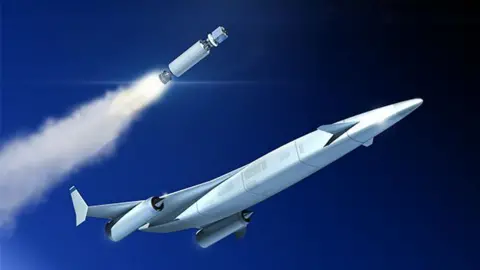AI Research
What happens when a high-tech project fails?

Technology Reporter
 Reaction Engines
Reaction Engines“It was going great until it fell apart.” Richard Varvill recalls the emotional shock that hits home when a high-tech venture goes off the rails.
The former chief technology officer speaks ruefully about his long career trying to bring a revolutionary aerospace engine to fruition at UK firm Reaction Engines.
The origins of Reaction Engines go back to the Hotol project in the 1980s. This was a futuristic space plane that caught the public imagination with the prospect of a British aircraft flying beyond the atmosphere.
The secret sauce of Hotol was heat exchanger technology, an attempt to cool the super-heated 1,000C air that enters an engine at hypersonic speeds.
Without cooling this will melt aluminium, and is, Mr Varvill says, “literally too hot to handle”.
Fast forward three decades to October 2024 and Reaction Engines was bringing the heat exchanger to life at sites in the UK and US.
UK Ministry of Defence funding took the company into hypersonic research with Rolls-Royce for an unmanned aircraft. But that was not enough to keep the business afloat.
Rolls-Royce declines to go into details about Reaction’s collapse, but Mr Varvill is more specific.
“Rolls-Royce said it had other priorities and the UK military has very little money.”
 Richard Varvill
Richard VarvillAviation is a business with a very long gestation time for a product. It can take 20 years to develop an aircraft. This unforgiving journey is known as crossing the Valley of Death.
Mr Varvill knew the business had to raise more funds towards the end of 2024 but big investors were reluctant to jump on board.
“The game was being played right to the very end, but to cross the Valley of Death in aerospace is very hard.”
What was the atmosphere like in those last days as the administrators moved in?
“It was pretty grim, we were all called into the lecture theatre and the managing director gave a speech about how the board ‘had tried everything’. Then came the unpleasant experience of handing over passes and getting personal items. It was definitely a bad day at the office.”
This bad day was too much for some. “A few people were in tears. A lot of them were shocked and upset because they’d hoped we could pull it off right up to the end.”
It was galling for Mr Varvill “because we were turning it around with an improved engine. Just as we were getting close to succeeding we failed. That’s a uniquely British characteristic.”
 Reaction Engines Ltd
Reaction Engines LtdDid they follow the traditional path after a mass lay-off and head to the nearest pub? “We had a very large party at my house. Otherwise it would have been pretty awful to have put all that effort into the company and not mark it in some way.”
His former colleague Kathryn Evans headed up the space effort, the work around hypersonic flight for the Ministry of Defence and opportunities to apply the technology in any other commercial areas.
When did she know the game was up? “It’s tricky to say when I knew it was going wrong, I was very hopeful to the end. While there was a lot of uncertainty there was a strong pipeline of opportunities.”
She remembers the moment the axe fell and she joined 200 colleagues in the HQ’s auditorium.
“It was the 31st of October, a Thursday, I knew it was bad news but when you’re made redundant with immediate effect there’s no time to think about it. We’d all been fighting right to the end so then my adrenalin crashed.”
And those final hours were recorded. One of her colleagues brought in a Polaroid camera. Portrait photos were taken and stuck on a board with message expressing what Reaction Engines meant to individuals.
What did Ms Evans write? “I will very much miss working with brilliant minds in a kind, supportive culture.”
Since then she’s been reflecting “on an unfinished mission and the technology’s potential”.
But her personal pride remains strong. “It was British engineering at its best and it’s important for people to hold their heads up high.”
Her boss Adam Dissel, president of Reaction Engines, ran the US arm of the business. He laments the unsuccessful struggle to wrest more funds from big names in aerospace.
“The technology consistently worked and was fairly mature. But some of our strategic investors weren’t excited enough to put more money in and that put others off.”
The main investors were Boeing, BAE Systems and Roll-Royce. He feels they could have done more to give the wider investment community confidence in Reaction Engines.
It would have avoided a lot of pain.
“My team had put heart and soul into the company and we had a good cry. “
Did they really shed tears? “Absolutely, I had my tears at our final meeting where we joined hands and stood up. I said ‘We still did great, take a bow.”
What lessons can we draw for other high-tech ventures? “You definitely have no choice but to be optimistic,” says Mr Dissel.
The grim procedure of winding down the business took over as passwords and laptops were collected while servers were backed up in case “some future incarnation of the business can be preserved”.
The company had been going in various guises for 35 years. “We didn’t want it to go to rust. I expect the administrator will look for a buyer for the intellectual property assets,” Mr Dissel adds.
Other former employees also hold out for a phoenix rising from the ashes. But the Valley of Death looms large.
“Reaction Engines was playing at the very edge of what was possible. We were working for the fastest engines and highest temperatures. We bit off the hard job,” says Mr Dissel.
Despite all this Mr Varvill’s own epitaph for the business overshadows technological milestones. “We failed because we ran out of money.”
AI Research
NFL player props, odds, lines: Week 2, 2025 NFL picks, SportsLine Machine Learning Model AI predictions, SGP

The Under went 12-4 in Week 1, indicating that not only were there fewer points scored than expected, but there were also fewer yards gained. Backing the Under with NFL prop bets was likely profitable for the opening slate of games, but will that maintain with Week 2 NFL props? Interestingly though, four of the five highest-scoring games last week were the primetime games, so if that holds, then the Overs for this week’s night games could be attractive with Week 2 NFL player props.
There’s a Monday Night Football doubleheader featuring star quarterbacks like Baker Mayfield, C.J. Stroud and Justin Herbert. The games also feature promising rookies such as Ashton Jeanty, Omarion Hampton and Emeka Egbuka. Prop lines are usually all over the place early in the season as sportsbooks attempt to establish a player’s potential, and you could take advantage of this with the right NFL picks. If you are looking for NFL prop bets or NFL parlays for Week 2, SportsLine has you covered with the top Week 2 player props from its Machine Learning Model AI.
Built using cutting-edge artificial intelligence and machine learning techniques by SportsLine’s Data Science team, AI Predictions and AI Ratings are generated for each player prop.
Now, with the Week 2 NFL schedule quickly approaching, SportsLine’s Machine Learning Model AI has identified the top NFL props from the biggest Week 2 games.
Week 2 NFL props for Sunday’s main slate
After analyzing the NFL props from Sunday’s main slate and examining the dozens of NFL player prop markets, the SportsLine’s Machine Learning Model AI says Lions receiver Amon-Ra St. Brown goes Over 63.5 receiving yards (-114) versus the Bears at 1 p.m. ET. Detroit will host this contest, which is notable as St. Brown has averaged 114 receiving yards over his last six home games. He had at least 70 receiving yards in both matchups versus the Bears a year ago.
Chicago allowed 12 receivers to go Over 63.5 receiving yards last season as the Bears’ pass defense is adept at keeping opponents out of the endzone but not as good at preventing yardage. Chicago allowed the highest yards per attempt and second-highest yards per completion in 2024. While St. Brown had just 45 yards in the opener, the last time he was held under 50 receiving yards, he then had 193 yards the following week. The SportsLine Machine Learning Model projects 82.5 yards for St. Brown in a 4.5-star pick. See more Week 2 NFL props here.
Week 2 NFL props for Vikings vs. Falcons on Sunday Night Football
After analyzing Falcons vs. Vikings props and examining the dozens of NFL player prop markets, the SportsLine’s Machine Learning Model AI says Falcons running back Bijan Robinson goes Over 65.5 rushing yards (-114). Robinson ran for 92 yards and a touchdown in Week 14 of last season versus Minnesota, despite the Vikings having the league’s No. 2 run defense a year ago. The SportsLine Machine Learning Model projects Robinson to have 81.8 yards on average in a 4.5-star prop pick. See more NFL props for Vikings vs. Falcons here.
You can make NFL prop bets on Robinson, Justin Jefferson and others with the Underdog Fantasy promo code CBSSPORTS2. Pick at Underdog Fantasy and get $50 in bonus funds after making a $5 wager:
Week 2 NFL props for Buccaneers vs. Texans on Monday Night Football
After analyzing Texans vs. Buccaneers props and examining the dozens of NFL player prop markets, the SportsLine’s Machine Learning Model AI says Bucs quarterback Baker Mayfield goes Under 235.5 passing yards (-114). While Houston has questions regarding its offense, there’s little worry about the team’s pass defense. In 2024, Houston had the second-most interceptions, the fourth-most sacks and allowed the fourth-worst passer rating. Since the start of last year, and including the playoffs, the Texans have held opposing QBs under 235.5 yards in 13 of 20 games. The SportsLine Machine Learning Model forecasts Mayfield to finish with just 200.1 passing yards, making the Under a 4-star NFL prop. See more NFL props for Buccaneers vs. Texans here.
You can also use the latest FanDuel promo code to get $300 in bonus bets instantly:
Week 2 NFL props for Chargers vs. Raiders on Monday Night Football
After analyzing Raiders vs. Chargers props and examining the dozens of NFL player prop markets, the SportsLine’s Machine Learning Model AI says Chargers quarterback Justin Herbert goes Under 254.5 passing yards (-114). The Raiders’ defense was underrated in preventing big passing plays a year ago as it ranked third in the NFL in average depth of target allowed. It forced QBs to dink and dunk their way down the field, which doesn’t lead to big passing yardages, and L.A. generally prefers to not throw the ball anyway. Just four teams attempted fewer passes last season than the Chargers, and with L.A. running for 156.5 yards versus Vegas last season, Herbert shouldn’t be overly active on Monday night. He’s forecasted to have 221.1 passing yards in a 4.5-star NFL prop bet. See more NFL props for Chargers vs. Raiders here.
How to make Week 2 NFL prop picks
SportsLine’s Machine Learning Model has identified another star who sails past his total and has dozens of NFL props rated 4 stars or better. You need to see the Machine Learning Model analysis before making any Week 2 NFL prop bets.
Which NFL prop picks should you target for Week 2, and which quarterback has multiple 5-star rated picks? Visit SportsLine to see the latest NFL player props from SportsLine’s Machine Learning Model that uses cutting-edge artificial intelligence to make its projections.
AI Research
What Is One of the Best Artificial Intelligence (AI) Stocks to Buy Now? – The Motley Fool
AI Research
Artificial Intelligence in Trauma and Orthopaedic Surgery: A Comprehensive Review From Diagnosis to Rehabilitation
-

 Business2 weeks ago
Business2 weeks agoThe Guardian view on Trump and the Fed: independence is no substitute for accountability | Editorial
-
Tools & Platforms1 month ago
Building Trust in Military AI Starts with Opening the Black Box – War on the Rocks
-

 Ethics & Policy2 months ago
Ethics & Policy2 months agoSDAIA Supports Saudi Arabia’s Leadership in Shaping Global AI Ethics, Policy, and Research – وكالة الأنباء السعودية
-

 Events & Conferences4 months ago
Events & Conferences4 months agoJourney to 1000 models: Scaling Instagram’s recommendation system
-

 Jobs & Careers3 months ago
Jobs & Careers3 months agoMumbai-based Perplexity Alternative Has 60k+ Users Without Funding
-

 Podcasts & Talks2 months ago
Podcasts & Talks2 months agoHappy 4th of July! 🎆 Made with Veo 3 in Gemini
-

 Education2 months ago
Education2 months agoVEX Robotics launches AI-powered classroom robotics system
-

 Education2 months ago
Education2 months agoMacron says UK and France have duty to tackle illegal migration ‘with humanity, solidarity and firmness’ – UK politics live | Politics
-

 Funding & Business3 months ago
Funding & Business3 months agoKayak and Expedia race to build AI travel agents that turn social posts into itineraries
-

 Podcasts & Talks2 months ago
Podcasts & Talks2 months agoOpenAI 🤝 @teamganassi




